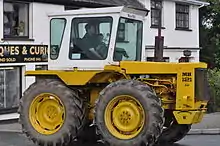Muir-Hill
Muir Hill (Engineers) Ltd was a general engineering company based at Old Trafford, Manchester, England. It was established in the early 1920s and was significant in the production of simple rail locomotives, and later high horse power tractors and post Second World War dumpers.
History

Muir Hill machinery have included basic petrol engined railway locomotives, mainly for narrow gauge. The early locos were little more than a Fordson tractor skid mounted on a rail chassis, with a chain connecting the rear axle of the tractor to the rail wheels. Production of locomotives did not continue beyond the 1930s; the company went on to build heavy tractors and construction equipment.
Muir-Hill moved on to producing dumpers also based on Fordson tractor skid units. They also built forklifts based on a tractor skid unit for a period before other manufacturers entered the market with better machines, and built some of the earlier articulated dumpers that evolved into the modern ADT. Muir-Hill later moved into tractor production which continued until the 1980s.
The company name and manufacturing rights transferred hands a number of times, first to E. Boydell and Co, then Winget, then Babcock & Wilcox, then Aveling-Barford, then to Lloyd Loaders (MH),[1]
Muir-Hill tractors have survived longer than comparable models, and a number have been subject to restoration. Threlkeld Quarry Museum holds examples of Muir Hill equipment.[2] The Ravenglass & Eskdale Railway has two examples.
Ffestiniog Railway
Users of Muir Hill locomotives included the slate quarries of Blaenau Ffestiniog.
This 4wPM locomotive of around 20 hp was constructed by Muir Hill (Engineers) Ltd in about 1922. It came to the FR on loan from the Aluminium Corporation's Cowlyd Reservoir Railway near Dolgarrog, arriving at Blaenau Ffestiniog on 9 April 1924. The loan was arranged by Henry Joseph Jack, who at the time controlled the WHR and FR and believed that a fleet of these units could provide cost-effective haulage for most purposes.[3]
Based on a Fordson tractor, the Muir Hill had three speeds in forward but only one in reverse. Trials were conducted in early May. It performed about as well as could have been reasonably expected, being barely able to pull 'an ordinary guards van' from Beddgelert to South Snowdon (Rhyd Ddu). Later in May it was tried to power the machinery at Boston Lodge. In a further trial it ran very well from Blaenau Ffestiniog to South Snowdon with a small van but could only return to Beddgelert at 2¼ mph because of its inadequate reverse gearing. These poor results were reported to the Board in June and the unit returned to Dolgarrog in August 1924.
Four-wheel-drive tractors
The company's four-wheel-drive tractors with equal sized wheels by fitting a driven front axle running from output from a sandwich plate between the gearbox and rear axle casings. Because of the size of the axle this meant the whole tractor was raised considerably from standard height. However the traction gains were considerable (as with County and Roadless tractors) and Muir-Hills have been and are used for heavy draught applications.
References
- "Muir-Hill", Muir-hill.co.uk. Retrieved 29 July 2013.
- "Threlkeld Vintage Excavator" Flickr photograph
- Henry Joseph Jack
Further reading
- Webb, Brian; The British Internal Combustion Locomotive 1894-1940, David & Charles, ISBN 0-7153-6115-5
- Gibbard, Stuart; Ford Tractor Conversions, Old Pond Publishing Ltd (2003). ISBN 1903366429
- Bradley, Vic "Industrial Railways of North Wales" Colonel Stephens Railway Museum web site
External links
![]() Media related to Muir-Hill tractors at Wikimedia Commons
Media related to Muir-Hill tractors at Wikimedia Commons
- Muir-Hill Website Official Muir-Hill Website
- Clevedon & Portishead Railway - used a Muir hill locomotive.
- Book featuring Muir Hill tractors